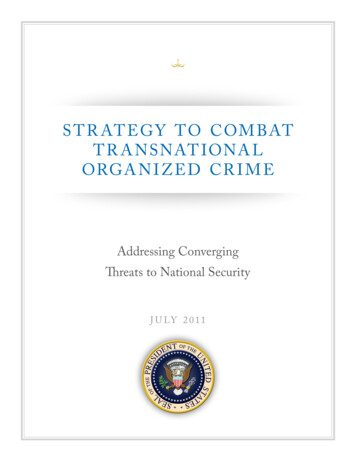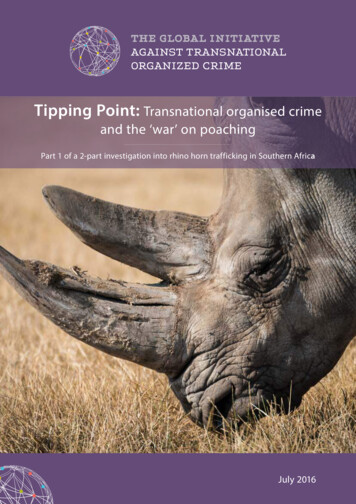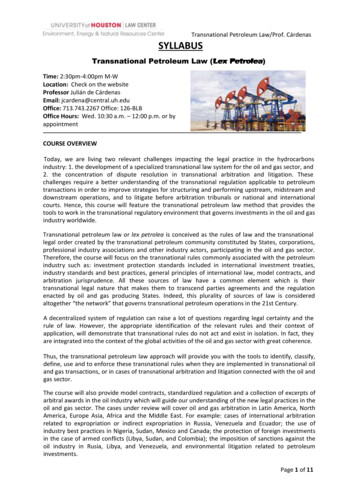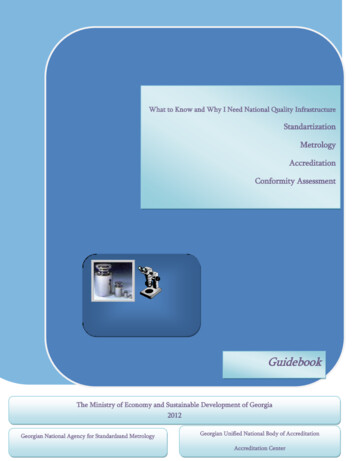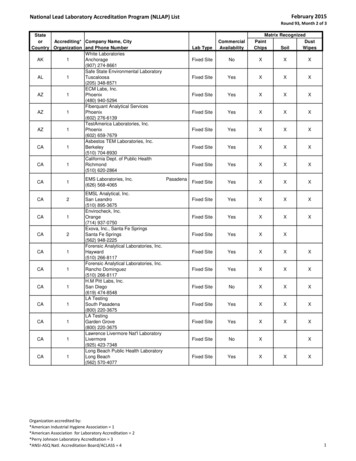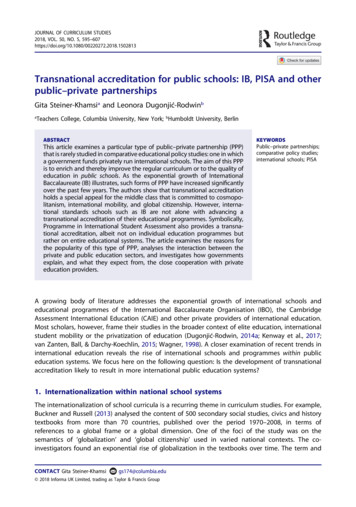
Transcription
JOURNAL OF CURRICULUM STUDIES2018, VOL. 50, NO. 5, 2813Transnational accreditation for public schools: IB, PISA and otherpublic–private partnershipsGita Steiner-Khamsia and Leonora Dugonjić-RodwinbaTeachers College, Columbia University, New York; bHumboldt University, BerlinABSTRACTKEYWORDSThis article examines a particular type of public–private partnership (PPP)that is rarely studied in comparative educational policy studies: one in whicha government funds privately run international schools. The aim of this PPPis to enrich and thereby improve the regular curriculum or to the quality ofeducation in public schools. As the exponential growth of InternationalBaccalaureate (IB) illustrates, such forms of PPP have increased significantlyover the past few years. The authors show that transnational accreditationholds a special appeal for the middle class that is committed to cosmopolitanism, international mobility, and global citizenship. However, international standards schools such as IB are not alone with advancing atransnational accreditation of their educational programmes. Symbolically,Programme in International Student Assessment also provides a transnational accreditation, albeit not on individual education programmes butrather on entire educational systems. The article examines the reasons forthe popularity of this type of PPP, analyses the interaction between theprivate and public education sectors, and investigates how governmentsexplain, and what they expect from, the close cooperation with privateeducation providers.Public–private partnerships;comparative policy studies;international schools; PISAA growing body of literature addresses the exponential growth of international schools andeducational programmes of the International Baccalaureate Organisation (IBO), the CambridgeAssessment International Education (CAIE) and other private providers of international education.Most scholars, however, frame their studies in the broader context of elite education, internationalstudent mobility or the privatization of education (Dugonjić-Rodwin, 2014a; Kenway et al., 2017;van Zanten, Ball, & Darchy-Koechlin, 2015; Wagner, 1998). A closer examination of recent trends ininternational education reveals the rise of international schools and programmes within publiceducation systems. We focus here on the following question: Is the development of transnationalaccreditation likely to result in more international public education systems?1. Internationalization within national school systemsThe internationalization of school curricula is a recurring theme in curriculum studies. For example,Buckner and Russell (2013) analysed the content of 500 secondary social studies, civics and historytextbooks from more than 70 countries, published over the period 1970–2008, in terms ofreferences to a global frame or a global dimension. One of the foci of the study was on thesemantics of ‘globalization’ and ‘global citizenship’ used in varied national contexts. The coinvestigators found an exponential rise of globalization in the textbooks over time. The term andCONTACT Gita Steiner-Khamsigs174@columbia.edu 2018 Informa UK Limited, trading as Taylor & Francis Group
596G. STEINER-KHAMSI AND L. DUGONJIC-RODWINthe concept did not exist in textbooks published in 1970 but was treated as a topic in almost 40%of the textbooks published in 2005. Similarly, ‘global citizenship’ needs to be regarded as arelatively new concept discussed in schools. By 2005, a quarter of the 70 countries’ textbooksexplicitly mentions the term. It would be wrong to assume, however, that the notion of globalcitizenship replaced national citizenship. Buckner and Russell (2013) found that the two conceptsnowadays exist side by side. They argue that ‘conceptions of global citizenship emerge ascomplementary rather than substitutive for national citizenship, indicating a vision of plus-national,rather than post-national, citizenship’ (Buckner & Russell, 2013, p. 5).A similar growth of international curricular content is present in the private school sector someof which explicitly use, among others, notions of global citizenship. In fact, the number ofinternational private schools has grown considerably over the past 50 years. There were only 372registered international schools in 1969; in 2017/18, there are 9318 according to the Global Reportof International Schools Consultancy (ISC). The same report (International Schools Consultancy,2018) predicts an explosive growth of international schools over the next few years and projectsthe establishment of nearly 6000 new ones over the next 7 years. In other words, ISC projects theestablishment of 15,100 international schools worldwide by the year 2025. According to Haydenand Thompson (2016), 23% of all schools with an international curriculum are schools affiliatedwith the IBO, thereby constituting the largest group of schools, followed by those that associatethemselves with CAIE.A nuanced analysis is needed here to understand the reasons for the exponential growth ofinternational schools. Hayden and Thompson (2016), for example, differentiate between three differenttypes of schools: Type A represents the traditional schools that cater to globally mobile expats, Type Bare ‘ideologically’ driven and pursue an international curriculum and finally Type C cater to wealthynational elites. The greatest growth occurred among the Type C schools. As a result, the majority ofstudents enrolled in international schools are nowadays nationals rather than children of a globallymobile elite workforce. Brummitt and Keeling (2013) estimated that 80% of seats in internationalschools are taken by national students. This shift from expats to nationals is, however, accompanied bya second, less explored trend within the Type C schools: governments that make contractual arrangements with private providers either to (1) offer an elective or international track within the public schoolor (2) use private international schools as hubs of innovation to serve as models of emulation forsurrounding schools and catalysts of change for the entire public school system. In the first type ofpublic–private partnership (PPP), international educational programmes exist side by side with nationalones. In the second type, international educational programmes serve as hubs of innovation tointernationalize or reform national public education.The growth of stand-alone international (private) schools that exist side by side with (national)public schools, on the one hand, and international education programmes, integrated into publicschools, on the other, reflects in large part the changed, pro-choice policy environment (see Verger,Fontdevila, & Zancajo, 2016). In addition, the flexibility in how the programme of an internationalprivate provider, such as the IBO, is adapted by governments or schools explains the popularity oftransnational accreditation. In the case of the International Baccalaureate (IB), the flexibility tricklesdown to the actual curriculum. In preparation for the IB exams, students are given several choices.They may prepare either a diploma or a certificate in one or more individual IB subjects. The diplomaprogramme comprises six groups of subjects: first language, second language, individuals andsocieties, mathematics and computer science, experimental sciences and the arts. The studentsmust take one subject from each of group, with the exception of the arts. Students may choose tosubstitute one of the subjects in the arts (e.g. music, art or theatre) with another subject from theother five curriculum areas. In addition to the six subjects, the student must write an extended essayin an area of their choice, follow a theory of knowledge course and participate in an extracurricularprogramme named ‘Creativity, Action, Service’ which comprises a large spectrum of electives.As Figure 1 shows, IBO programmes experienced close to 40% growth over a 5-year period. Themost popular programme is the diploma programme, offered for students aged 16–19. The number of
JOURNAL OF CURRICULUM 87114140201220132014201520161410Career CertificateMiddle Years ProgrammePrimary Years ProgrammeDiploma Programme2017Figure 1. Growth of IB programmes, 2012–2017.diploma programmes increased from 2346 to 3101 schools over the period 2012–2017. IBO offers fourtypes of educational programmes (primary years, middle years, diploma and career-related programmes). By 2018, 150 countries adopted one or more IBO programmes. Over half of IBO schoolsare located in the Americas. More specifically, in 2008/9, over a third were located in the United Statesand close to 91% of these were local public schools (Dugonjić-Rodwin, 2014a).The list of governments that enter a PPP agreement with the IBO grows continuously(International Baccalaureate Organisation (IBO), 2018a). The Organization lists the following 10governments that, by the year 2018, offer one or more IBO programmes as part of the nationaleducation system: Canada, Ecuador, Germany, Japan, Malaysia, Republic of Armenia, Republic ofMacedonia, Spain, United Arab Emirates and the United States of America. In reality, however, thereare more districts and countries (such as Kazakhstan) that have adopted IB programmes andcollaborate with the IBO.1.1. International tracks within public schoolsThe term ‘curricular markets’, coined by Doherty and Shield (2012), best describes the wide array ofeducational programmes offered in IB schools. In fact, the International School in Geneva pioneered one such market already in the 1930s, 20 years before the inception of the IB. Conceived as‘a kind of Miniature League of Nations’, the school was coeducational, bilingual—teaching in thetwo official languages of the League—and international. The first group of students (four Swiss,four Americans and one French) and teachers (one American, one German/Russian and one Swiss)were seen as ‘nationalities represented’ in the school or the micro-cosmos of the League ofNations, respectively. The students were prepared for the French baccalaureat or the Swissmaturité on the so-called French side and the College Board examination, the Cambridge entranceor the Canadian matriculation on the ‘English side’ (Dugonjić-Rodwin, 2014b). Although the 1930curricular market was locally confined to Geneva, the continuous interest and establishment ofsuch schools in other countries boomed in the 1950s and led the School to gather a dozen othersinto an international network, first under the name International Schools’ Association (1951) and
598G. STEINER-KHAMSI AND L. DUGONJIC-RODWINlater on the International Schools Examination Syndicate (1964), an autonomous organization thatdeveloped a private high school curriculum and diploma—originally the ‘international schoolsbaccalaureate’, through workshops and conferences uniting teachers and education specialistswith heads of state, officers and ministers of education. The latter was renamed the IB Office in1968 and came to be known by governments and universities around the globe as theInternational Baccalaureate or the ‘IB’ (Dugonjić-Rodwin, 2014a).The main feature of the curriculum is, in the words of the IB founders, ‘general culture throughspecialization’ (Peterson, 2003, p. 42). Conceived as a ‘third way’—neither encyclopaedic noroverspecialized knowledge—the vision of general knowledge, taught in IB schools, was seen as acurricular reform movement that could potentially promote innovation among national educationsystems around the globe. The new conceptualization of general knowledge signalled a cleardeparture both from the traditional ‘encyclopaedic’ approach to education, often embodied by theFrench model, as well as the opposite, the overspecialization attributed to the English system in the1960s (Peterson, 2003). For the founders of IB, general knowledge in secondary schools had totranscend the study of the traditional humanities:Taste, reasoning and culture can be developed through any subject, provided that the aim in teaching it is toensure study in depth and not encyclopedic knowledge. A pupil may be a truer ‘humanist’ as a result of a wellconceived course in history, in world literature in translation or in a science than he will be after six years of drygrammatical exercises in Latin. (ISES/SEEI Archive 1966 cited in Dugonjic-Rodwin, 2014a)Thus, in a strategic shift from content to form, the IB programme considers ‘learning to learn’,‘critical thinking’ and ‘international mindedness’ as the core elements of its curriculum. Today, withthe IB offered in some countries either in parallel or partially integrated in public schools, thefounders’ vision of a reform movement has come true. On the one hand, the IB curriculum hasgreatly resonated with some governments, school districts or schools that respond to requests ofmiddle-class parents to offer a transnationally accredited diploma programme in addition to theregular national exit exam in upper secondary school. On the other, IB schools have grown evermore inclusive of public institutions over the past 40 years. The modalities of this inclusion varyacross regions, nations, provinces, municipalities and sometimes even individual schools.Based on the sources of funding and the actors involved in decision-making, Resnik (2016) uses thelens of actor-network theory to identify a continuum of three ‘assemblages’ that are located betweentwo extremes: ‘IB private’ and ‘IB national’, with ‘IB public’ in the middle. One extreme designates a localcontext where private IB schools prevail as in Argentina and Chile. In this ‘assemblage’, the expenses aredistributed among parents and the main actors (school boards, principals) negotiate the integration ofthe IB in their schools directly with the IBO. The other extreme refers to a situation where nationalgovernments are involved in setting the terms of the contract with the IBO, as in Ecuador, where the IBis seen as a means for improving secondary education. In this case, expenses are covered by the centralgovernment and the main actors are officers at the Ministry of Education, the provincial educationalauthorities, although they also involve senior school staff. Finally, Spain is a good example of the ‘IBpublic assemblage’, which groups all other modalities of IB integration situated between these twoextremes. There, the proportion of IB public and private schools is relatively balanced since the mid1980s, when the first schools joined the Organization. As Resnik explains, individual actors with closeties to IB have played a key role for establishing PPPs. For example, the former principal of an IB schoolin Quito, Raul Vallejo, was appointed as Minister of Education and was in a position to actively propelthe spread of the IB model throughout Ecuador. Another example is the Municipality of Madrid, whichplayed a key role in bringing the IB to public schools in Spain. It helped alleviate the financial burdenfrom schools that were candidates for membership in the Organization (Resnik, 2016). While thedistinction between national and public assemblages may be confusing for scholars from theJapanese or English system, this typology usefully sums up how the IB is embedded in local schools.The question of who covers the cost is essential, as the IB is expensive. While the IBO’s activityconsists in developing school programmes, examinations and evaluation criteria, assessing
JOURNAL OF CURRICULUM STUDIES599candidates as well as awarding diplomas, subscriptions and examinations are the organization’smain sources of income. Member schools’ contributions are financially proportional to the numberof candidates they prepare for the exams and the number of subjects taught. Admission fees percandidate and evaluation fees per subject can thus vary among IB schools.1 In addition to the costper capita, the school must also make funds available for the professional development of itsteachers and other quality assurance measures determined by IBO.The questions of cost and of curriculum being closely related, the IBO offers certificates as analternative to the expensive diploma. Although the philosophy of the IBO is to promote the diplomarather than the certificates (IBO, 2018d), candidates may choose certificates in one or few subjects only.The certificates are less challenging for the students and less expensive for the school. To useBourdieu’s terminology, schools that present many certificate candidates tend to be relatively poorin terms of both economic and cultural capital. The IB Diploma programme is academically moredemanding, because candidates must study six subjects (five of which are compulsory) while thoseenrolled in a Certificate Programme choose their subjects à la carte. In Ecuador, for example, budgetaryconstraints have resulted in a scripted curriculum with little choice: the IB Diploma Programmeprepares students in first-language Spanish, second-language English, history, mathematics, biologyor chemistry and entrepreneurship and management (Resnik, 2014).Costs also determine the availability of teachers for delivering the IB. Recruitment modalitiesvary according to countries and the legal status of schools. In private schools such as the UnitedNations International School in New York, teachers are recruited in international education fairs(Dugonjic-Rodwin, 2014a). While the education sector of Ecuador lacks qualified teachers, let alonequalified IB teachers (Resnik, 2014), in states such as Florida, IB teachers receive a 50 bonus foreach student that earns a qualifying score on the exam (Resnik, 2015). More generally, IB teachersare trained to teach the IB as part of lifelong learning. Moreover, in lieu of inspectors, a teachertakes up the position of IB Coordinator in a given school. As a centralizing agency, the IBO thusfavours the circulation of teachers within its own network of schools. Once trained, teachers canteach in any IB school, thereby establishing in itself a segmented job market, where anglophoneteachers, especially British, have a bit of a lock-hold on teaching and managerial positions partlydue to their language skills and partly to the private character of their national education systems(Benson, 2011; Canterford, 2003). Thus, the implementation of the IB requires a certain level ofrestructuring which may have profound effects on national education systems and markets.Although the IBO intervenes at a later stage of teacher education in comparison to state systems,the IB-specific in-service training may have long-lasting effects on schools too, as educationalvalues, techniques and practice all converge in the classroom. Short as they are, these are rareoccasions for teachers to discuss evaluation criteria in view of standardizing their practice.In an earlier empirical study, Dugonjic-Rodwin (2014a) performed a multiple correspondenceanalysis (MCA)2 drawing on IBO’s database for IB candidates from 1579 schools in 124 countries in2008–9. Based on this analysis of the market for the IB, she characterized it as an ‘economy ofsymbolic goods’ (Bourdieu, 1985). The findings vary based on the distribution of schools accordingto the volume and composition of what she calls ‘candidate capital’, arguing first that thetransaction between the IBO and its member schools is not exclusively economic and, second,that the symbolic dimension is prevalent in international education. The results of the MCA showthe global community of IB schools structured around two main axes, the character and thevolume of their candidate capital according to the following key features: seniority (duration ofthe school’s membership in the IBO), size (number of IB candidates that the school prepares for theIB), geographic origin (nationality of IB candidates), candidates’ choices of language and of IBformat (diploma or certificates). In sum, the horizontal or symbolic axis distances private international schools from local state schools, while the vertical or economic axis opposes large established schools to small recent ones. Finally, the more established schools also tend to be moreinternationalized, i.e. they assemble candidates of a greater range of nationalities and offer a largerspectrum of IB subjects. In contrast, schools newer to the IB emerge as outsiders, in the MCA, i.e.
600G. STEINER-KHAMSI AND L. DUGONJIC-RODWINthey are diploma-oriented and anglophile, with a strong focus on learning or consolidatingcandidates’ English. Thus comparing schools according to their candidate capital takes intoaccount the salient cleavages.Reasons why the IB resonates, and how it is translated or implemented in a local context, varywidely. Ecuador and Japan, two economies at opposite ends in terms of GDP (gross-domesticproduct), have a similar use of the IB. Both are what Resnik calls ‘IB national assemblages’. Animportant difference, however, is the language barrier—which is beyond the reach of the ‘assemblage’ typology. Due to the language barrier, the initial project of expanding IBO school membership in Japan had to be modified: the English-only option was replaced with the Dual-Languageoption in English and Japanese (Yamamoto, 2016). In the same way, the assemblage approach islimited if we are to understand the paradox of local state schools in the United States, which areeconomically established in terms of numbers of candidates they prepare for the IB, yet symbolicoutsiders as their candidates are largely local (Dugonjić-Rodwin, 2014a). While an approach usingMCA is a powerful empirical tool to compare IB schools beyond their country-specific determinantsand reconstruct structural cleavages on a global level, it is rarely sufficient because cleavages tendto be enacted in IB teachers’ discourse or individual school strategies. It is thus best combined withethnographic fieldwork as well as historical inquiry.1.2. International schools as reform hubs: spilling over and scaling up of innovationIn this study, we differentiate between two types of PPPs. The first type, described in the previoussection of the article, captures IB programmes that are established with public financial supportand are offered side by side with regular public schools. In some countries, this particular type ismade possible because of choice, voucher schemes or ‘endemic privatization’ in education (see Ball& Youdell, 2008). In contrast, the second type represents IB schools that are supposed to serve ashubs of innovation for the education system. Whereas the first type of PPP exemplified in theintegration of the IB diploma programme as a track within public schools, the second type of PPPenvisions the use of private providers for innovating or internationalizing all public schools. In fact,the government expects in the second type of PPP the innovation, implemented in a few pilotinternational standard schools (ISS), to first spill over to neighbouring public schools and tosubsequently scale it up to the national level. This second type of PPP is briefly sketched in thissection of the article.This second type of PPP is a remarkable case of transnational (private) accreditation of national(public) schools that deserves attention and investigation (see Hartmann, 2016; Resnik, 2012;Verger, Steiner-Khamsi, & Lubienski, 2017). This particular kind of partnership with the privatesector to infuse and disseminate innovation in the public sector is especially pronounced indeveloping countries. Different from many other pilot projects, the ISS are not donor-driven butare government initiated. Nevertheless, similar to the more common type of donor-funded pilotschools, sometimes labelled partner or project schools, several governments in low- and middlelow-income countries have established over the past decade ISSs as centres of innovation with theexpectations that the ‘best practices’ from these schools spill over to other schools in the districtand are scaled up nationwide.Perhaps the most ambitious initiative of using International Standards-Pilot Schools ascatalysts for improving the quality of education was the International Standards (ISS) schemein Indonesia. Over a period of 10 years, only (2003–2013) 1339 schools were established underthe scheme. It would have been necessary to transform 884 more regular schools into ISS inorder to achieve the government’s nationwide reform plan. The 2003 Education Law (Article 50,paragraph 3) mandated the establishment an ‘international standard educational unit’ in eachdistrict to ensure that eventually all schools in a district benefit by means of spillover and scaleup. The full-fledged ISS had to fulfil nine rigorous quality assurance criteria including the use ofEnglish as a language of instruction in math and the natural sciences and certification by a
JOURNAL OF CURRICULUM STUDIES601school accreditation body from one of the Organisation for Economic Co-Operation andDevelopment (OECD) member states. The quality assurance criteria were rigorous to the extentthat by the end of the reform, not a single of the 1339 schools was in a position to providesufficient evidence that it had fulfilled all nine requirements (ACDP, 2013; Coleman, 2011).Furthermore, the evaluation of the ISS initiative demonstrated that the schools had admitted88% of students who had an upper- and middle-income socio-economic status, thereby violating the requirement that 20% of the students had to be recruited from low-income families(ACDP, 2013). Clearly, the scheme was not only applauded for systematically targeting qualityimprovement in schools but was also heavily criticized for disregarding equity concerns giventhat parents were expected to financially contribute. What is more, the Government ofIndonesia was attacked for allocating four times more financial resources from the nationaleducation budget to the ISS than to regular schools. Finally, in January 2013, the ConstitutionalCourt of Indonesia ruled against the ISS and determined that they were unconstitutional,because access to them was unequal and equal educational opportunities therefore not warranted. The Court contended that charging fees had led to a ‘commercialization of the education sector’ and implied that ‘quality education would become an expensive item that only therich could afford’ (Johnson, 2011).Regardless of equity and cost-effectiveness concerns in Indonesia and other countries where ISSswere implemented, the concept of International Standards-Pilot School as a reform modality forpiloting, demonstrating and disseminating ‘best practices’ in education has spread like wildfire indeveloping countries over the past few years. Proponents argue that training a few schools in depthand providing resources to these schools in order to disseminate ‘best practices’ is a more effective andsustainable reform modality than distributing the limited human and material resources to all schoolsin the country. As a result, the proponents of ISSs have developed interesting strategies of how toeffectively target spillover and scale-up, using a variety of train-the-trainers, peer-training and cascadeprogrammes, in which the trained teachers provide the same training to teachers in surroundingschools, who in turn train others in the catchment area of their school etc.The Indonesian concept of ISS included, among other accreditation criteria, an adoption ofborrowed curriculum standards from an OECD country. Any national curriculum standards wereeligible for ISS accreditation as long as the standards originated in an OECD country. Thus, thetransnational accreditation was bilateral and country-specific. In the case of Kazakhstan andMongolia, however, the governments collaborated with the global private sector: with IBO andCambridge International Assessment Education (CIAE), respectively. The international schools,which serve as catalysts for reform, are called Nazarbayev Intellectual Schools (NIS). The NISnetwork comprised 21 schools in 2017. With the purpose to serve as the channels of translatingbest practices across the country, these schools are located in different regions of the country.More specifically, they are based in all the 17 major cities of Kazakhstan including Astana andAlmaty. In Mongolia, there were supposed to be 20 schools tailored after the curriculum of theCambridge International General Certificate of Secondary Education. Bending under pressure fromcivil society, however, the incoming Minister of Education and Science reduced in 2014 thatnumber to three schools, based in Ulaanbaatar, and highlighted the important role of these socalled Cambridge-Standards Laboratory Schools for mainstreaming competency-based curricula,the use of instructional technology and high-stakes student tests at critical stages of their schoolcareers. Similar to the NIS that adopted IBO educational programmes in 21 schools of Kazakhstan,the Cambridge-Standards Laboratory Schools in Mongolia receive technical assistance fromCambridge International Examinations. In both countries, English as a language of instruction inthe STEM subjects (science, technology, engineering and math) constitutes an attractive feature ofthe international schools.Over the past 20 years or so, the two countries have developed in different directions, both interms of economic growth and educational development. Kazakhstan grew within a period of twodecades from a lower middle income to an upper middle income country and its GDP per capita in
602G. STEINER-KHAMSI AND L. DUGONJIC-RODWIN2016 is 10,518. Mongolia experienced, thanks to the mining sector, for a few years a period ofexplosive economic growth and has nowadays a GDP per capita of 4370 (World Bank data).Governments in both countries emphasize the importance of establishing a ‘world class’ educationsystem that rigorously pursues international standards. Politicians in both countries point at theimportance to boost English
diploma programmes increased from 2346 to 3101 schools over the period 2012-2017. ibo offers fourtypes of educational programmes (primary years, middle years, diploma and career-related pro-grammes). by 2018, 150 countries adopted one or more ibo programmes. over half of ibo schoolsare located in the americas. more specifically, in 2008/9, over a

